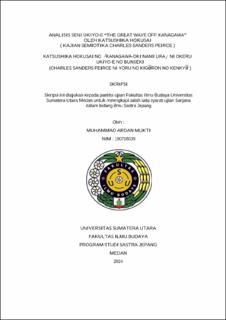Analisis Seni Ukiyo-E “The Great Wave Off Kanagawa” oleh Katsushika Hokusai ( Kajian Semiotika Charles Sanders Peirce ) Katsushika Hokusai No (Kanagawa-Oki Nami Ura) Ni Okeru Ukiyo-E No Bunseki (Charles Sanders Peirce Ni Yoru No Kigoron No KenkyU)
Katsushika Hokusai No (Kanagawa-Oki Nami Ura) Ni Okeru Ukiyo-E No Bunseki (Charles Sanders Peirce Ni Yoru No Kigoron No KenkyU )

Date
2024Author
Mukti, Muhammad Ardan
Advisor(s)
Muliadi, Yuddi Adrian
Alimansyar
Metadata
Show full item recordAbstract
This study discusses the meaning of existing signs and the meaning of the Ukiyo-E painting "The Great Wave Off Kanagawa" by Katsushika Hokusai. In this study, the author used a descriptive research method. The theory used in this study is the semiotics theory by Charles Sanders Peirce. The purpose of this study is to understand the meaning of the Ukiyo-E painting "The Great Wave Off Kanagawa”. In this painting, there are three main visual elements: the sea and waves, a mountain in the background, and fishing boats. From the analysis of the signs in the Ukiyo-E painting "The Great Wave Off Kanagawa" several meanings were found, such as the two main colors in this painting, blue and white, which symbolize tranquility and purity. Mount Fuji in the background, which symbolizes eternity, and the large waves with foam tips resembling claws, which signify danger or threat. The painting "The Great Wave Off Kanagawa" has three main meanings: first, in reality, the painting tells the story of fishermen collecting fish cargo to sell in the Edo market but encountering a large wave in the Kanagawa sea. Second, in the political context of the Edo period, this painting signifies the impending collapse of the Tokugawa clan's rule, which had dominated Japan for 264 years, marking the beginning of the Meiji Restoration. Lastly, this painting serves as a reminder to the Japanese people of the lurking danger of tsunami disasters.
Collections
- Undergraduate Theses [562]
